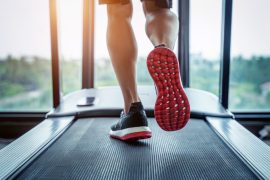We know that significant reductions in workplace sitting are achievable. But how does reducing sitting impact on workers’ health? We examined this using data from our Stand Up Victoria intervention – a 12 month intervention in office workers that used organizational-, environmental- (including sit-stand workstations) and individual-level approaches to reduce prolonged workplace sitting time in desk-based workers.
What did we do? We recruited 14 work teams and over 200 workers (136 intervention; 95 control) from the one organisation to take part in this cluster randomised controlled trial. We measured 14 biomarkers of body composition, blood pressure, glucose metabolism, lipid metabolism and a composite overall cardio-metabolic risk score in both the intervention and control participants at three time points: before the intervention, after three months of the intervention (end of the intensive intervention phase), and after 12 months.
What did we find? We found a significant, beneficial intervention effect for fasting glucose and the clustered metabolic risk score at the 12 month assessment. This beneficial effect for fasting glucose was mainly due to the control group getting worse over the 12 months. There were no significant intervention effects observed at 3 months. Notably, sitting was primarily replaced with standing.
What does this mean? These findings show that in this “healthy worker” population (i.e. a population not chosen because they were at risk of poor cardio-metabolic health), there may be some small benefits to heart health of reducing sitting time. Importantly, given that the rates of type 2 diabetes are continuing to escalate, not getting worse is still likely to be a clinically relevant outcome.
So… what next? This is one of the first steps in understanding the potential impact of reducing sitting time on markers of cardio-metabolic health. There is a need for longer term, wider-scale investigations, including in populations that may benefit most (e.g. type 2 diabetes, overweight/obese). There is also the need to understand how much it matters what the sitting is replaced with. But overall, these results suggest that by taking a stand, you are making the first step towards improving your heart health.*
Findings were published in the May 2017 edition of Medicine and Science in Sports and Exercise. A more detailed commentary on this article can be found here.
Healy GN, Winkler EAH, Eakin EG, Owen N, Lamontagne AD, Moodie M, et al. A Cluster RCT to Reduce Workers’ Sitting Time: Impact on Cardiometabolic Biomarkers. Med Sci Sports Exerc. 2017 Oct;49(10):2032-9.
*Warning – very bad pun alert.










Comments are closed.